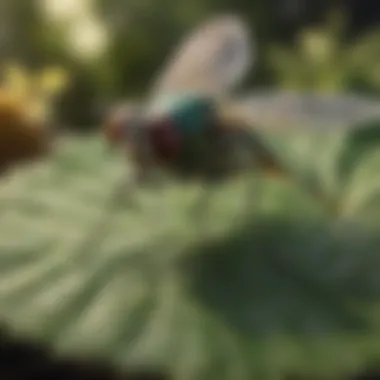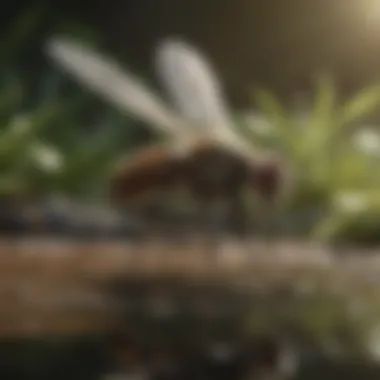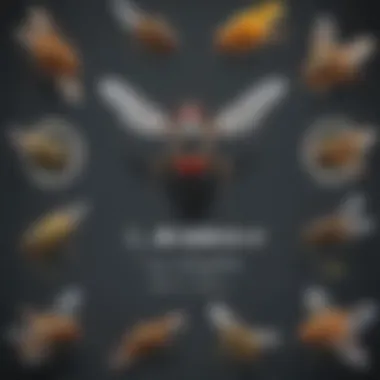Understanding Shore Flies: Impact and Management


Intro
The presence of pests in the home is a concern for many. Shore flies are one such insect that can enter domestic spaces and cause discomfort. Understanding these insects is crucial for effective management. In this article, we will delve into the characteristics of shore flies, their behavior, and the methods available for control and prevention. This exploration aims to empower homeowners with knowledge and practical strategies to mitigate possible infestations.
Understanding Pests
Definition of Pests
Pests are organisms that cause harm or discomfort in human habitats. Along with shore flies, other common pests include ants, cockroaches, and mosquitoes. These organisms can disrupt the environment and pose health risks.
Importance of Pest Identification
Identifying pests accurately is essential. Understanding the specific pest allows for tailored management strategies. Shore flies, for example, are often confused with other small flies. Correct identification aids in choosing the right approach for control. Misidentifying pests may lead to ineffective treatments. Therefore, paying attention to physical characteristics and behavior is crucial.
Prevention Techniques
Home and Garden Preventative Measures
Effective prevention starts at home. Shore flies breed in moist areas, so it's vital to reduce standing water around the home. Here are some key measures homeowners can take:
- Eliminate Standing Water: Regularly check pots, birdbaths, and drains.
- Clear Debris: Remove any unwanted plant material or compost that attracts flies.
- Seal Entry Points: Ensure windows and doors are properly sealed to prevent entry.
Seasonal Prevention Tips
Seasons can influence pest activity. During warmer months, shore flies may be more prevalent. To combat this:
- Monitor Moisture Levels: During the rainy season, check for leaks in pipes and roofs.
- Maintain Cleanliness: Regularly clean gutters and downspouts to prevent water accumulation.
Eco-Friendly Pest Control Solutions
Overview of Sustainable Practices
Sustainability is becoming increasingly important in pest management. Many homeowners prefer eco-friendly approaches. Using natural methods helps protect the environment while effectively addressing pest problems.
Natural Remedies and Their Effectiveness
Several natural remedies can deter shore flies. Some of them include:
- Essential Oils: Oils like peppermint and eucalyptus may repel shore flies.
- Diatomaceous Earth: This powder can be sprinkled in areas where flies are present, causing dehydration to the insects.
"Utilizing natural solutions not only aids in pest control but also fosters a healthier living environment."
By adopting these methods, homeowners can create a less inviting space for shore flies while minimizing their environmental impact.
Prolusion to Shore Flies
The study of shore flies is significant for a number of reasons. These insects may seem minor, but their presence in home environments can lead to various challenges. Recognizing these flies and understanding their behavior is crucial for homeowners. This article aims to provide a comprehensive overview of shore flies, emphasizing their relevance in domestic spaces. As people become more invested in maintaining clean living environments, knowledge about these little creatures becomes increasingly valuable.
Definition and Overview of Shore Flies
Shore flies belong to the family Ephydridae, a group of small flies commonly found in damp areas. They are often seen near water bodies such as lakes, rivers, and even in muddy places. The name "shore flies" is derived from their typical habitation near aquatic environments. These insects have a unique appearance characterized by their dark, often shiny bodies, and small size, which usually ranges from 3 to 7 mm in length. Understanding their life cycle, feeding habits, and behavior is essential for addressing any potential infestations they might cause within homes.
Distinction Between Shore Flies and Other Flies


Shore flies can be easily confused with other more common household flies. However, there are distinct differences that set them apart. Unlike fruit flies, which are attracted to fermenting produce, shore flies prefer decaying organic material, particularly in areas with high moisture. Also, shore flies often appear in swarms near water sources.
Another notable distinction is in their flight patterns. Shore flies have a characteristic darting flight, resembling that of a moth, unlike the more erratic movements of house flies. Homeowners can tell them apart by observing these behaviors and their preferred environments.
Identifying shore flies correctly is a vital first step toward effective pest management. Understanding these differences enhances awareness and aids in the implementation of targeted control measures.
Biology of Shore Flies
The biological aspects of shore flies offer crucial insights into their behavior and life cycle. Understanding these elements not only aids in identification but can also reveal patterns that help in effective control measures. Their biology informs homeowners of the lifecycle phases, which can correlate with the timing of infestations. Additionally, recognizing physical characteristics can empower residents to distinguish shore flies from other troubling species. Knowledge of their feeding habits fosters informed decisions about prevention and control strategies, creating a more healthy living environment.
Life Cycle and Development Stages
Shore flies undergo distinct life stages: egg, larva, pupa, and adult. The cycle typically begins when female shore flies lay their eggs in moist substrates such as decaying organic matter. Eggs hatch within a week or so, leading to the larval stage. Larvae are small and primarily feed on decomposing plant material. This stage lasts a few days to several weeks, depending on environmental conditions. After estaablishing adequate food sources, larvae pupate. The pupal stage can vary in duration but generally lasts a week or longer. Once complete, adult shore flies emerge. The entire cycle from egg to adult can take between two weeks to a month.
Physical Characteristics
Shore flies are often confused with other fly species due to their physical similarities. Adult shore flies are about 3 to 7 mm in length. They usually possess dark brown or black coloring with distinctive wing patterns. Their wings are broad and often held flat, which can be a key identifying trait. Furthermore, their long, slender legs help facilitate their movement over surfaces. Understanding these visual traits can greatly enhance identification.
Feeding Habits
Shore flies are saprophagous, meaning they primarily feed on decaying organic material. This diet provides essential nutrients for growth and development. They are attracted to moist environments and often found near piles of compost or water bodies. Adult shore flies can also feed on secretions from plants, contributing to their ecological role as decomposers in various ecosystems. By understanding these feeding habits, homeowners can better manage their presence, particularly by limiting standing water and organic waste that may attract them.
"The biology of shore flies is a critical aspect in determining effective control measures and understanding their presence in and around homes."
Behavior of Shore Flies
Understanding the behavior of shore flies is crucial for homeowners and pest management professionals. Their habits provide insight into why these flies may appear in domestic spaces and how to effectively manage their populations. Identifying their behaviors allows for targeted control measures that can reduce the likelihood of infestation.
Habitat Preferences
Shore flies thrive in moist environments. They are often found near water bodies, including lakes and wetlands. In homes, they seek habitats that provide humidity and organic matter. Common areas include bathrooms, basements, and kitchens, particularly around drains and standing water. Shore flies are also attracted to decaying organic material. Therefore, maintaining cleanliness in these spaces is essential to discourage their presence.
Reproductive Behavior and Mating
Shore flies have specific reproductive habits that contribute to their population growth. Females typically lay eggs in damp substrates, ideally where food sources are abundant. This behavior ensures that their larvae have adequate resources when they hatch. Mating occurs in proximity to breeding sites, often during warm periods. Understanding this cycle is vital because it can inform preventative strategies. Reducing moisture levels and addressing waste can disrupt their breeding patterns, minimizing the chance of infestations.
Flight Patterns and Activity Levels
Shore flies exhibit distinct flight patterns influenced by their environmental conditions. They are generally weak fliers, preferring to stay close to their habitats. Their activity levels increase with warmth and humidity. During cooler temperatures or dry conditions, their movements become less frequent. Monitoring these patterns can help determine the best times for control methods. For instance, applying insecticides while flies are active can enhance effectiveness.
Proper understanding of shore fly behavior leads to effective pest management strategies. By recognizing their habitat preferences, mating habits, and activity patterns, one can significantly reduce their presence in homes.
Identification of Shore Flies
Identifying shore flies is a crucial step in managing their populations, particularly within home environments. Understanding how to recognize these insects allows homeowners to take timely action to mitigate potential infestations. This section will explore various aspects of identification, including common species found in homes, key visual characteristics, and indicators of an infestation. The goal is to equip you with the knowledge to differentiate shore flies from other common household insects.
Common Species Found in Homes
Shore flies belong to the family Ephydridae. Several species are frequently noted in residential areas. The most prevalent among these is Scatella stagnalis, commonly found around stagnant water and decaying organic matter. Another species, Ephydra gracilis, is often seen in areas with moisture and organic buildup. These species are often mistaken for more common house flies, which further emphasizes the importance of proper identification. Understanding which species are common can guide homeowners in effectively addressing specific infestations.
Visual Characteristics for Accurate Identification
Properly identifying shore flies involves examining their physical characteristics. Typically, shore flies are small, measuring about two to six millimeters in length. They possess distinctive wings that are often dark and non-membranous. Their bodies are generally stout and may feature a grey or black coloration, sometimes with a slight sheen.


Some tips for accurate identification include:
- Body Shape: Shore flies tend to have a robust and rounded appearance.
- Wing Structure: Observe the wings; they usually rest flat over the body when not in flight.
- Antennae: The antennae are short and often exhibit a slight curve.
- Legs: Their legs may appear hairy, which is a distinguishing feature. Identifying these features can help you confirm the presence of shore flies versus other similar insects.
Indicators of Shore Fly Infestation
Recognizing signs of infestation is essential to address problems early. Common indicators of shore fly presence include:
- Visible Flies: You may observe small dark flies congregating near sources of moisture.
- Breeding Sites: These flies are attracted to damp decaying organic matter such as compost piles or overwatered plants.
- Fecal Spots: Shore flies leave behind tiny dark fecal spots around where they breed; this can also clue you into their presence.
Keep an eye on these signs, as swift action can prevent a minor issue from escalating into a larger infestation.
By understanding the common species, visual characteristics, and infestation indicators, homeowners can confidently identify shore flies. This knowledge is an essential part of managing their impact on home environments.
Shore Flies and Home Environments
Understanding the interaction between shore flies and home environments is crucial for effective pest management. Shore flies are not simply a nuisance; their presence correlates with specific environmental conditions and can indicate underlying issues within domestic spaces. Recognizing these connections allows homeowners to implement appropriate measures, minimizing disturbances from these insects while maintaining hygiene and comfort.
Why Shore Flies Enter Homes
Shore flies are drawn to homes for various reasons, primarily linked to their reproductive and feeding habits. These flies thrive in damp environments, making areas such as kitchens, bathrooms, and basements particularly attractive. Here are some specific factors that lure shore flies indoors:
- Moisture: Excess humidity or water accumulation can provide a suitable habitat for shore flies.
- Food Sources: Organic material such as decomposing fruits, vegetables, and stagnant water can serve as food for these pests.
- Temperature: Warm indoor temperatures appeal to shore flies, especially in colder months when outside conditions are less favorable.
Understanding why shore flies seek refuge in homes can assist in preventive measures and reduction of their populations.
Common Entry Points for Shore Flies
Identifying common entry points for shore flies is essential for creating an effective pest control strategy. These flies can gain access through several means. Here are notable entry points:
- Open Windows and Doors: Gaps or openings can serve as direct access for shore flies, especially in warmer months when windows are frequently opened.
- Cracks and Crevices: Shore flies can enter homes through cracks in walls, foundations, or around window frames.
- Plumbing Fixtures: Any leaks or moisture around sinks and drains can create an invitation for these pests.
By sealing potential entry points, homeowners can significantly reduce the likelihood of shore fly infestations, promoting a healthier living environment.
Impact of Shore Flies in Homes
Understanding the impact of shore flies in residential spaces is critical for homeowners. These insects, while often overlooked, can pose several challenges. Their presence may indicate underlying problems with moisture or other environmental factors. Recognizing the problems associated with shore flies is essential for effective management and the maintenance of a healthy living environment.
Potential Health Risks
Shore flies might not be the most dangerous insects compared to others, but they can still present potential health risks. These flies are known for gathering near the humid and damp areas of the home. In doing so, they may inadvertently attract other pests, including those that might carry diseases. While direct transmission of diseases from shore flies to humans is limited, their presence can complicate existing hygiene issues within the household. Homeowners should be cautious, particularly in areas where food is stored or prepared. Regular cleaning can help minimize risks associated with these pests.
Effects on Household Hygiene
The effects of shore flies on household hygiene are significant. These insects often thrive in places with decaying organic matter, particularly where moisture is prevalent. They can breed rapidly, leading to an increase in their population in a short time. This rapid multiplication can result in unsightly infestations that disrupt daily activities.
Effective sanitation practices are vital.
This includes proper waste management, cleaning food spills immediately, and ensuring good ventilation in the home. If left unchecked, the accumulation of shore flies and their potential breeding sites can lead to a decline in overall household cleanliness. Maintaining a hygienic living environment is crucial for comfort and health. Homeowners must recognize the importance of proactive measures for pest management, especially concerning shore flies.
By understanding the impact that these flies can have on health and hygiene, homeowners can take informed steps to maintain their living spaces.
Control Measures for Shore Flies


Managing shore flies in residential spaces is crucial for maintaining not only cleanliness but also overall health in the home. Shore flies can easily become a nuisance if their population is not controlled effectively. Implementing the right control measures minimizes their presence, ensuring a more pleasant living environment. This section will cover preventive strategies, chemical control options, and biological control methods, each contributing to an integrated approach in managing these flies.
Preventive Strategies
Prevention is often the most effective tactic when dealing with shore flies. Homeowners can take certain steps to deter these pests from entering their living spaces. Here are some essential strategies:
- Maintain Cleanliness: Regular cleaning can significantly reduce the attraction of shore flies. Remove any food debris and spills immediately.
- Seal Entry Points: Inspect windows and doors for any gaps through which flies might enter and seal these openings.
- Proper Waste Management: Ensure trash cans are tightly sealed and regularly emptied to minimize potential food sources for shore flies.
- Wrapper Excess Moisture: Shore flies are attracted to damp environments. Fix leaks and avoid overwatering plants to decrease this attraction.
By following these preventive measures, homeowners can create an environment less conducive to shore fly infestations.
Chemical Control Options
When preventive strategies do not suffice, chemical control measures can be considered. However, it is vital to select products that are effective yet safe for indoor use. Here are a few options:
- Insecticidal Sprays: Products like Raid Flying Insect Killer can be sprayed directly on shore flies when spotted. However, it is advisable to ventilate the area afterward.
- Sanitation Insecticides: Use insecticides that target larvae, as addressing both adult flies and their offspring can help reduce the overall population.
- Bait Traps: Utilizing bait traps can help capture shore flies and is a less invasive option for homes.
Caution is paramount when using chemical products. Always read the label for instructions and safety measures to prevent any unintended harm.
Biological Control Methods
For those interested in eco-friendly solutions, biological control methods offer a sustainable alternative to chemical products. These options often include:
- Natural Predators: Introducing natural predators, such as certain types of wasps, can effectively reduce the shore fly population. However, this requires careful management and knowledge.
- Beneficial Microorganisms: Utilizing beneficial nematodes can help in controlling fly larvae in soil. Applying products containing these microorganisms can reduce future infestations.
Incorporating biological controls can lead to a balanced ecosystem in the home, minimizing the reliance on harsh chemicals.
It is essential to apply an integrated pest management approach when addressing shore flies in homes. Combining preventive, chemical, and biological methods can significantly enhance overall effectiveness.
Sustainable Pest Management Practices
Sustainable pest management practices are essential in addressing the challenge posed by shore flies in homes. By adopting eco-friendly solutions, homeowners not only protect their living environment, but also lessen the impact on the surrounding ecosystem. These methods promote a balance between pest control and environmental responsibility, which is increasingly important in today's society. Particularly relevant for housewives and house owners, sustainable practices utilize non-toxic substances and preventive measures that support long-term functionality.
The benefits of sustainable pest management include a reduction in chemical exposure to household members and pets. Importantly, these methods often focus on preventing infestations rather than merely reacting to them. Considerations include understanding the biology of shore flies, their habitat preferences, and their life cycles. An informed approach helps target the specified problem without causing unnecessary harm to beneficial insects or the environment.
"The key to effective sustainable pest management lies in understanding both the pest and the environment."
Eco-Friendly Solutions for Shore Fly Control
Several eco-friendly solutions exist for managing shore flies effectively within the home. One effective method involves the use of foods that disrupt shore fly reproduction. For instance, vinegar or overripe fruits can attract and trap these pests. The smell draws them in, but importantly, this method does not expose the home to harmful chemicals.
Another solution is to implement physical barriers. Using screens on windows and doors can prevent shore flies from entering while still allowing fresh air into the home. For those with plants both inside and outside, maintaining cleanliness is crucial. Removing decaying matter and ensuring plants are free of debris can significantly minimize the attraction for flies.
Integrating Pest Management Techniques
Integrating pest management techniques is imperative for a holistic approach to shore fly control. This method, known as Integrated Pest Management (IPM), combines various strategies to reduce pest populations effectively. For house owners, this approach often involves monitoring shore fly activity and implementing a combination of cultural, mechanical, and biological controls.
Cultural controls include practices like maintaining proper sanitation. This can mean cleaning up food spills and ensuring garbage is sealed tightly. Mechanical controls might involve setting up traps or barriers as discussed earlier. Additionally, it may be helpful to introduce natural predators, such as certain wasps that feed on shore flies, especially in outdoor spaces.
Culmination and Future Directions
The examination of shore flies in the home environment holds critical importance for homeowners and pest management professionals alike. Understanding these insects not only enhances our knowledge of their behavior but also provides insights on effective control measures. As we have explored throughout this article, shore flies can present unique challenges in domestic settings. By recognizing their characteristics and habits, effective management can be achieved.
In summary, the key points outlined include identifying common shore fly species, understanding their biology, and implementing preventive strategies. Each of these aspects helps to mitigate potential infestations. Additionally, prioritizing eco-friendly pest control methods demonstrates a commitment to sustainability. With increasing urbanization and changes in climate, shore flies may adapt and expand their range, making ongoing education and research essential.
Future directions in this field should focus on:
- Identifying seasonal patterns of shore flies to better predict outbreaks.
- Investigating the relationship between shore flies and other household pests to create integrated management solutions.
- Exploring advanced ecological methods to control shore fly populations without harmful chemicals.
Understanding these elements can lead to more nuanced pest management systems that align with environmental health and household welfare. A continuous cycle of research and adaptation is necessary to effectively address the challenges posed by shore flies.



